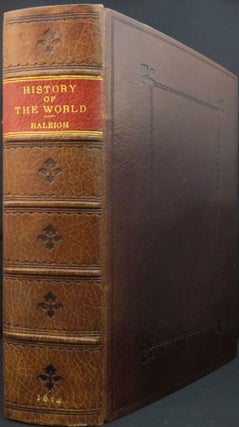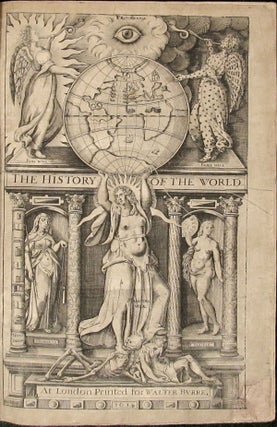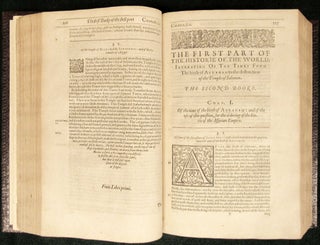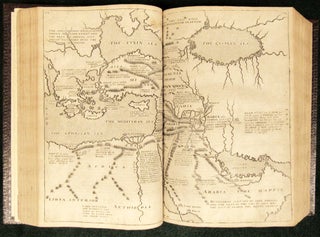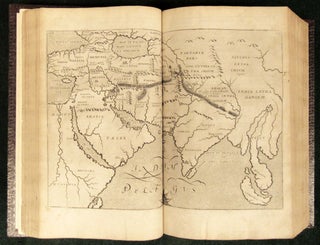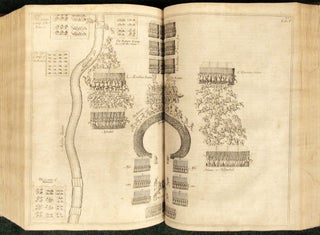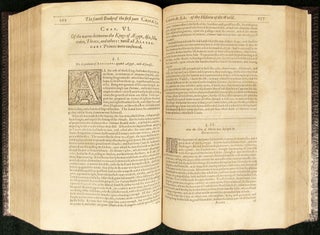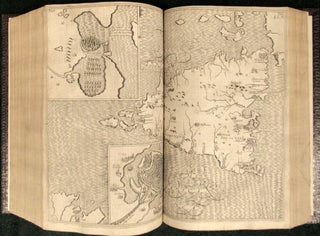THE HISTORY OF THE WORLD
(London: Printed for W. Barre, 1614).
RARE FIRST EDITION OF RALEIGH'S MASSIVE WORK AND A CORNERSTONE WORK IN HISTORIOGRAPHY. ONE OF THE GREAT BOOKS PRINTED IN ENGLAND AT THE BEGINNING OF THE 1600's. This is the earlier of the two editions having the colophon dated 1614, with the errata uncorrected. The engraved title was not issued with the second edition, which appeared in 1617, a printed title having a portrait of Raleigh taking its place. A reissue of the second edition appeared in 1621, and later editions in 1624, 1628, 1666, and 1684, 1687 and throughout the 18th century.
This is the only volume published of the massive history Raleigh planned and began while in the Tower of London after the accession of James I. It was rigidly suppressed by order of King James I, but nevertheless passed through several editions. While most of his prose works up to then had been written fro private circulation[...] the HISTORY was intended for publication to a wide audience. Raleigh began writing it about 1607, the work was entered in the Stationers' register in 1611 and appeared towards the end of 1614. The preface was suppressed by George Abbot, archbishop of Canterbury, on 22 December and copies were seized by the kings' agents for this own use. According to Chamberlain the suppression came about because it was "too sawcie in censuring princes" [...] The suppression order was soon lifted and the History was reprinted in 1617. It remained popular: there were at least eleven editions in the seventeenth century, one in the eighteenth, and one in the nineteenth.
Raleigh was one of the principal figures of the English Renaissance. As well as being a poet of wide repute and a successful soldier, he was one of the earliest explorers of the New World (one of its cities still bears his name). This ambitious book, which Raleigh worked on with the help of several assistants, ostensibly deals with Greek, Egyptian, and biblical history up to 168 B.C., but the preface summarizes modern European history and represents one of the earliest English views of the world and its history. It has become a classic of English Renassaince literature.
The History is described as "The first part of the general history of the world", implying, as Ralegh said, that other parts were to come. This, he admitted, was his intention and indeed he had "hewn them out". What exists is a substantial work, of about a million words, in five books, running from the creation of the world to 146 B.C., the time of the second Macedonian war. The first two books are principally, though not wholly, concerned with biblical history, the last three mainly with the story of Greece and Rome. In the first two, God's judgments are seen as the central determinants of events; in the latter three the role of man is more evident. History is regarded as moral exemplum, a classical concept appropriate ot the treatment of ancient history but unusual for the subsequent discussion of Henry VIII. The juxtaposition of the discussion of Henry with that of James must have registered as ironic with the original readers, especially later when James's "unstained sword of justice" had Ralegh's blood on it. The HISTORY IS FAR MORE THAN A CHRONOLOGY, ITS OPENING CHAPTERS DESCRIBED THE CREATION OF THE WORLD AND ITS NATURE BEFORE RALEGH MOVED TO THE PHILOSOPHICAL PROBLEMS RAISED BY THE CONCEPTS OF PRESCIENCE, PROVIDENCE, FREE WILL AND FORTUNE. He adopted the familiar distinction between first and second causes, God' Will, he later wrote, determined everything [...] yet God works through second causes, "Instruments, Causes and Pipes", which carry his will to the world. The distinction is not clear or unambiguous, but it enabled Ralegh to focus upon human actions. Essentially, he wrote for a purpose, as a man of action: it was, he said, "the end and scope of all History, to teach by example of times past, such wisdom as my guide our desires and actions" (ODNB). perhaps unsurprisingly, given his previous experiences, one of Raleigh's principal themes was 'the general wickedness of kings and the severity of God's judgement upon them [...] The misdeeds of English kings were related in some detail. o Henry VIII Ralegh wrote that "if all the pictures and patterns of a merciless prince were lost in the World, they might again be painted to the life, out of the story of this king" [...] Only one ruler in the entire history of the world receives unstinted and unadulterated praise from Ralegh: Epaminondas of Thebes, with Hannibal as proxime accessit. Although Ralegh believed that history could provide examples and precepts for rulers to follow, its events demonstrated only too clearly that they were unlikely to do so. His book ends with a paean of praise to Death: "Oh eloquent, just and mighty Death! whom none could advise, thou has persuaded; that none has dared, thou hast done; and whom all the world hath flattered, thou only hath cast out of the world and despised: thou hast drawn together all the far stretched greatness, all the pride, cruelty, and ambition of man, and covered it over with these two narrow words, Hic jacet" (loc.cit.) The poem "The Mind of the Front' (i.e. explanation of the allegorical frontispiece) was written by Ben Jonson, who had been tutor to Raleigh's son at the time of the book's production. Item #28056
First edition, first issue, with the Errata leaf at the end and with the dating of 1614 on the colophon leaf. With the engraved title-page and the "Minde of the Frontispiece" leaf, and 8 double-page plates and maps as issued, and with a great profusion of decorated multi-line initials throughout and charts and decorations in the text. Folio (12.75 by 8.25 inches), very handsomely bound in dark honey-brown morocco, the covers with triple blind fillet rules at the borders, surrounding a central panel ruled in blind and with fleurons in the corners. The spine is designed in six compartments, each with a fleuron in blind, and with a red morocco label lettered in gilt. [4m Frontispiece, Minde of the Front], [40, preface], [40, Contents of the Chapters], 1-651, [3, blanks], 1-776, [2, To the Reader], 26, A Chronologicall Table], [16, An Alphabeticall Table...of the First and Second Bookes], [16, An Alphaeticall Table ...of the Third, Fourth and Fift Bookes], [2, errata] pp. A handsome and pleasing copy, the text-block large and well preserved, quite crisp and clean throughout, the opening two leaves as is usual, with some expert refurbishment and strengthening, some evidence of damp, old and faint to some of the initial leaves, withal a fine copy, with the covers beautifully preserved and the spine panel handsomely accomplished.

